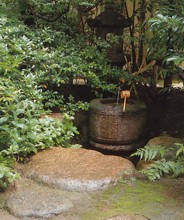Japanese Tea Ceremony
| Japanese Tea Ceremony |
|
By: Dr Paul Lam
|
|
The tea ceremony originally came from China based on ancient Chinese tea ceremony. Some of the methods that have been changed in China are still retained in Japan. The most notable is the tea in powder form. In the Sung dynasty hundreds of years ago, Chinese tea was no longer made by grinding the tea leaves into powder. It was changed to soaking tea leaves in boiled water like English tea. However, the Japanese in their tea ceremony use very specific techniques to grind the tea leaves into powder, and mix it with water to make the tea. The tea ceremony is so sophisticated and ingrained into the Japanese culture that it is known as a part of national cultures. I really liked several features of the ceremony, for example: 1. A spiritual emphasis. The host and the guest approach this ceremony with sincerity and a positive spirit of sharing. I find that most intriguing, almost like practising Tai Chi with your friends. 2. The thorough preparations. If a person can afford it, he or she builds a tearoom or teahouse just to make tea. Some people have a garden leading to a simple artistic teahouse. I would love to do this. The tearoom has to be set up in a certain way. The host starts by cleaning the tearoom, and by painstakingly setting out the utensils and decorations. 3. The aesthetic value. They take everything into consideration as far as aesthetic value-the way the tea is presented, how the utensils and other objects are displayed, the settings and the environment It's really nice to have your tea served along with the right spirit, right atmosphere, and the right procedure, again, almost like doing Tai Chi in an ideal setting.
Japanese history tells of some tea masters who became so powerful that they became close to the rulers. One of them came so close that he threatened his ruler's power. I have trouble imagining a tea master being that powerful. I would love to incorporate some of what I learned in Japan into my art of making tea, so next time you're my guest expect a cup of my Kung Fu tea in my garden teahouse. But don't hold your breath. It is going to quite a while, as my top priority is to sow the seeds of Tai Chi for Health around the world, the tea can wait. |

 In September 2002, I was in Japan for one week. I love making and drinking Chinese tea, so I took the opportunity to learn more about the Japanese tea ceremony. (I drink Kung Fu tea daily. Read
In September 2002, I was in Japan for one week. I love making and drinking Chinese tea, so I took the opportunity to learn more about the Japanese tea ceremony. (I drink Kung Fu tea daily. Read  While I tried to learn as much as I could about the Japanese tea ceremony, the procedures and the protocol are so complicated that I ended with the impression that just to be a guest, you have to go through a training school to learn the etiquette. As to learning the art of serving tea, there is so much skill involved that it'sa full-time profession for many. In a way, I felt that the many strict protocols of the ceremony hindered free spirit.
While I tried to learn as much as I could about the Japanese tea ceremony, the procedures and the protocol are so complicated that I ended with the impression that just to be a guest, you have to go through a training school to learn the etiquette. As to learning the art of serving tea, there is so much skill involved that it'sa full-time profession for many. In a way, I felt that the many strict protocols of the ceremony hindered free spirit.